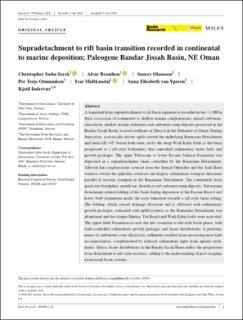| dc.contributor.author | Serck, Christopher Sæbø | |
| dc.contributor.author | Braathen, Alvar | |
| dc.contributor.author | Olaussen, Snorre | |
| dc.contributor.author | Osmundsen, Per Terje | |
| dc.contributor.author | Midtkandal, Ivar | |
| dc.contributor.author | van Yperen, Anna Elisabeth | |
| dc.contributor.author | Indrevær, Kjetil | |
| dc.date.accessioned | 2020-09-14T08:15:21Z | |
| dc.date.available | 2020-09-14T08:15:21Z | |
| dc.date.created | 2020-06-11T23:01:47Z | |
| dc.date.issued | 2020 | |
| dc.identifier.issn | 0950-091X | |
| dc.identifier.uri | https://hdl.handle.net/11250/2677555 | |
| dc.description.abstract | A transition from supradetachment to rift basin signature is recorded in the ~1,500 m thick succession of continental to shallow marine conglomerates, mixed carbonate‐siliciclastic shallow marine sediments and carbonate ramp deposits preserved in the Bandar Jissah Basin, located southeast of Muscat in the Sultanate of Oman. During deposition, isostatically‐driven uplift rotated the underlying Banurama Detachment and basin fill ~45° before both were cut by the steep Wadi Kabir Fault as the basin progressed to a rift‐style bathymetry that controlled sedimentary facies belts and growth packages. The upper Paleocene to lower Eocene Jafnayn Formation was deposited in a supradetachment basin controlled by the Banurama Detachment. Alluvial fan conglomerates sourced from the Semail Ophiolite and the Saih Hatat window overlie the ophiolitic substrate and display sedimentary transport directions parallel to tectonic transport in the Banurama Detachment. The continental strata grade into braidplain, mouth bar, shoreface and carbonate ramp deposits. Subsequent detachment‐related folding of the basin during deposition of the Eocene Rusayl and lower Seeb formations marks the early transition towards a rift‐style basin setting. The folding, which caused drainage diversion and is affiliated with sedimentary growth packages, coincided with uplift‐isostasy as the Banurama Detachment was abandoned and the steeper Marina, Yiti Beach and Wadi Kabir faults were activated. The upper Seeb Formation records the late transition to rift‐style basin phase, with fault‐controlled sedimentary growth packages and facies distributions. A predominance of carbonates over siliciclastic sediments resulted from increasing near‐fault accommodation, complemented by reduced sedimentary input from upland catchments. Hence, facies distributions in the Bandar Jissah Basin reflect the progression from detachment to rift‐style tectonics, adding to the understanding of post‐orogenic extensional basin systems. | en_US |
| dc.language.iso | eng | en_US |
| dc.publisher | Wiley | en_US |
| dc.relation.uri | https://onlinelibrary.wiley.com/doi/abs/10.1111/bre.12484 | |
| dc.rights | Navngivelse 4.0 Internasjonal | * |
| dc.rights.uri | http://creativecommons.org/licenses/by/4.0/deed.no | * |
| dc.title | Supradetachment to rift basin transition recorded in continental to marine deposition; Paleogene Bandar Jissah Basin, NE Oman | en_US |
| dc.type | Peer reviewed | en_US |
| dc.type | Journal article | en_US |
| dc.description.version | publishedVersion | en_US |
| dc.source.journal | Basin Research | en_US |
| dc.identifier.doi | 10.1111/bre.12484 | |
| dc.identifier.cristin | 1815138 | |
| dc.relation.project | Norges forskningsråd: 295208 | en_US |
| dc.relation.project | Norges forskningsråd: 228107 | en_US |
| dc.description.localcode | © 2020 The Authors. Basin Research published by International Association of Sedimentologists and European Association of Geoscientists and Engineers and John Wiley & Sons Ltd This is an open access article under the terms of the Creative Commons Attribution License, which permits use, distribution and reproduction in any medium, provided the original work is properly cited. | en_US |
| cristin.ispublished | true | |
| cristin.fulltext | original | |
| cristin.qualitycode | 2 | |

